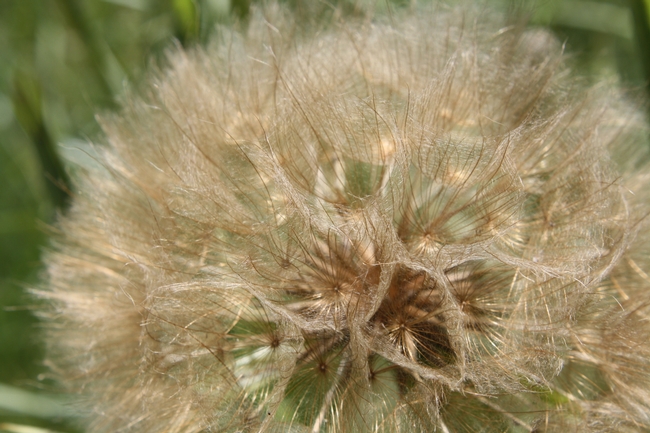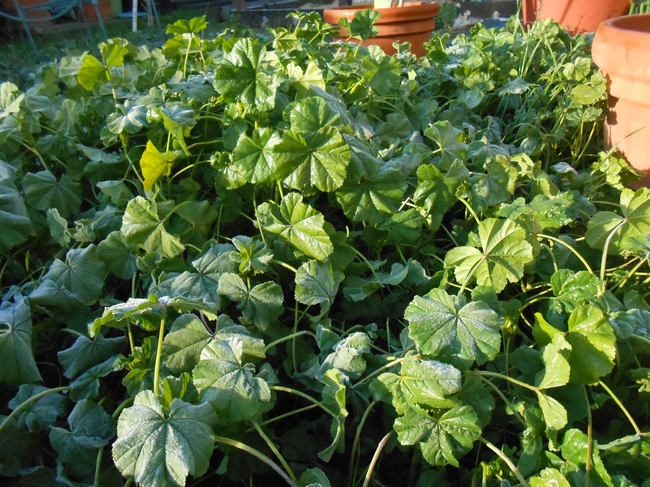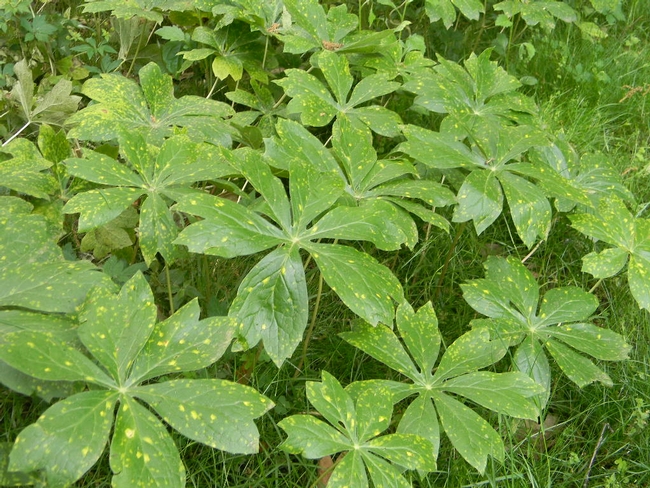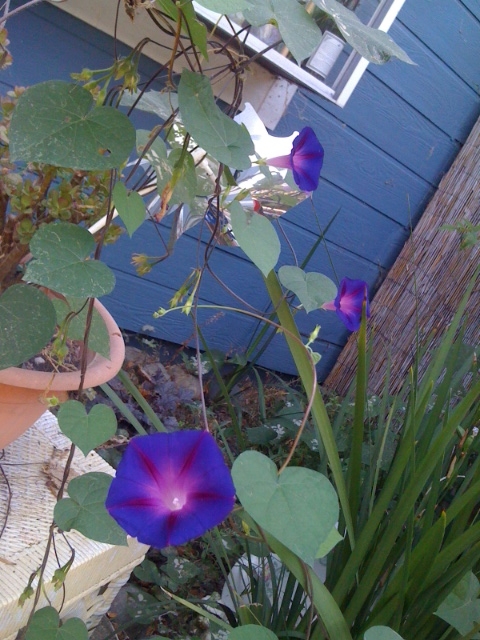- Author: Betsy Buxton
Here I am, writing when I could be outside either flying the dog or ripping out more weeds from the “dry” creek. That darn “dry” creek has more water in it just now since the rain yesterday than the dog’s water bowl. I wasn’t really kidding about flying the dog as LuLu weighs just over 9 pounds and has very large ears and there is a very stiff wind blowing. Bruce and I joke around that at a time like this, hitch LuLu to her leash and let her soar instead of walk to the nearby park.
Earlier this week, we got down and dirty with the chemicals in the war against Bermudagrass, various other grass varieties, and my old “buddy” – oyster salsify! Using the IPM system, we have managed to NOT hold our own against these “arch fiends” of the home and garden.
Nope, not a napalm strike exactly, but the judicious use of herbicides and pre-emergents to keep from mowing in the house itself.
Pre-emergents are very useful tools in order to contain weed seeds when used at the proper time. Use in October for the spring weed seeds and again in February for the fall and winter weed seeds. It’s very simple and quite easy. I missed out in October because there was no rain; with the product I use, I need at least ½ inch of water. With Bruce, no rain = no spray; it’s not that he’s not a believer, but water = $$$ which he is loathe to spend. With rain, he’s raring to go, so it got done!
The grass spraying is a more delicate proposition. Using an all-purpose herbicide means death to any plant getting hit. So the game plan is: select the target, find an herbicide for that particular target group and read, READ the label. Select the appropriate product and use according to the directions to the letter!
So far, the spraying of the grassy weeds in the rose beds, the backyard potion of the dry creek, and the other areas of the back and side yards has been completed. I’m holding my breath that the guaranteed shades of red and/or brown will appear showing the weed plants are on the way out and make the other grassy weeds quake on their roots.
The last few years have been the years of grassy weeds. When we first started out here, there was nothing but tumbleweeds growing in the back forty. It only took 2 years to get rid of them but now, in a way, I wish those tumbleweeds, Russian thistle (Salsola iberica) were still here. I don’t know if you’ve read in the little magazines from the newspapers that some towns have festivals with prizes for the best use of the things and the having the biggest! Wow, my crops would have taken 1st prizes and built mansions! Alas, this information has come years too late!
Next were the years of the bristly oxtongue (Picris echioides). That stuff grows everywhere, and if you get dermatitis from it as I do – it got left alone as Bruce doesn’t do “prickle bushes” and I worked well out of town. Then came dandelions and finally the oyster salsify and the Bermudagrass. Unfortunately, for this group of weeds, I’m retired now and have all the time in world – my back allowing – for pulling up and hoeing the little darlings! The beautiful thing these days is now I’m the supervisor now at home and I’ve given myself a long lunch, starting now. See ya!!

- Author: Betsy Buxton
I’m sitting at the computer while waiting for the promised rain to begin. Waiting and waiting; there’s a method to all this though: when the rain comes, the ground will soften and the weeds will be easier to pull.
I have magnificent oyster salsify (Tragopogon porrifolius L.) weeds growing in the front and side yards of the house. I have learned that having a house at the end of a cul de sac is the best way to get weed seeds blown into the yard – living 1 block in a straight line from the Suisun Marsh doesn’t help either. If I were to be taking a weed class, I would have all sorts of both grassy and broadleaf weeds to preserve as samples!
Meanwhile, the oyster salsifies are hanging on to the soil with the large, white fleshy roots that like lovely parsnips, just waiting to go to flower and then to seed. And the amount of seeds!! Each with its own little helicopter of a sail, ready to fly away and repeat the cycle – again and again, until the stand of plants are shoulder to shoulder and keeping other (meaning, wanted) plants from the area.
When the ground is wet and the flower stalks have grown to approximately 1 ½ feet to 2 feet, that’s when you can easily pull them out. But remember, as members of the aster family which includes Spiny Sowthistles (Sonchus asper), pulled plants and even just broken off flower heads will continue to mature into seed heads! Toss them immediately that day into the garbage or green waste container! If you don’t, you have just condensed the seeds into a single area and you have definitely not “doubled your pleasure”!
I would not suggest merely mowing salsifies down to get rid of them, as the root will raise another flower stalk which will be shorter and shorter the more it’s cut. Using herbicides on them is not too successful, as the leaves and stems have a thick cuticle (rather smooth layer which has a tendency to allow liquids to run off) and it seems as though more spray is needed, thereby increasing the possibility of hurting the desired plants.
Besides, there is a great deal of pleasure when the darned thing pops out, you put it in the bucket, and realize that there’s 1 less in the yard!
Hope to see some of you at the talk at Annie’s Annuals on April 13th at 10-ish for the FREE talk on using natives in the garden, and again on May 25 for the talk on Salvias. I don’t get anything for mentioning these talks but they’re good for Continuing Ed and the speakers are pros and answer all questions!


- Author: Patricia Brantley
Mallow is driving me crazy! We can’t get rid of the stuff! So this year (that indicates that we’ve been at this a while) we think we’re going to outsmart it. First, since the stuff just doesn’t die, frost, intense heat, dogs, and so on, we’re going to yank as much out now with our hands covered in mittens and heads in warm fleece caps with hopes that NO seeds will develop or fall into the frozen ground. Ha! Next, we’re going to cover the ground, AGAIN, where it was growing, with cardboard or old karate mats (yes, old karate mats). Third, we’re going to plant something else on the ground as a cover, or actual landscaping, anything once it’s warm enough for anything else to survive. I tell you, this stuff could grow in the Arctic or the Sahara! Arrrghh! Mallow, you are my nemesis!
http://www.ipm.ucdavis.edu/PMG/PESTNOTES/pn74127.html



- Author: Betty Victor
On a recent trip to the Midwest, I came across one of their native plants. This plant has a variety of names depending on the part of the Midwest it grows in. I was in Missouri and there it is called Mayapple (Podophyllum peltatum), in other parts of the Midwest it may be called May pop, devils apple, raccoon berry, just to name a few. In researching this plant I found it is a member of the Berberidaceae family.
The Mayapple is an unusual plant. It grows in the woods and areas that stay wet most of the year. The one I saw was at the edge of woods not far from a running creek. It is a low growing plant that appears to spread maybe by rhizomes, because of where it was growing it was hard to tell as there was poison ivy growing there as well.
When it is still young it has a single stem with one large umbrella looking leaf. As it ages, which usually is sometime in April, the leaf and stem split creating 2 leaves and 2 stems the flower. You have to look for is in the bottom part of the 2 stems that come together. Since the weather in Missouri is unusual this year, the plant is late in blooming, so the split had not happened when I was there.
I was told that the flower hides underneath the leaves until the stem grows a stalk 12-18 inches tall. It is only then the large white flower appears. After the flower fades large yellow fruit appear. The fruit is said to be edible, but only when it is fully ripe, which is when they have lost their green color, but I would not advise eating it. If consumed in large amounts, the danger of toxicity occurs. NOTE: UC Master Gardeners do not recommend eating anything without proper identification by a professional botanist.

- Author: Esther E Blanco
As I start to ponder the complexities of all my thoughts related to gardening, I find myself thinking about vivid memories of childhood gardens long ago, and the need to draw silly analogies from the simplest of tasks in the garden, which seemed to so eloquently parallel lessons taught by everyday life - epiphanies, irony and humility.
It seems to me, that I always want what I can’t have. I desperately pull weeds when they so tenaciously grow without any need for pampering, irrigation, or fertilizer. They even come back when I chop them off and pulled them up -- roots and all. Even, when I am fully convinced that I’ve removed that final pesky weed, I discover the following spring, that it had already carefully spread about 10,000 of its offspring – all now happily sprouting in my yard.

It seems so ironic, my quest to create a perfect garden. I’m convinced that gardens are Mother Nature’s way to humble human beings. To make us realize that we can’t control our lives, we cannot always have things go the way we plan. And in the end, we must learn plan, hope, pray and finally have faith that the sun will shine and garden, like life, will sprout, grow and renew itself again -- weeds and all.



